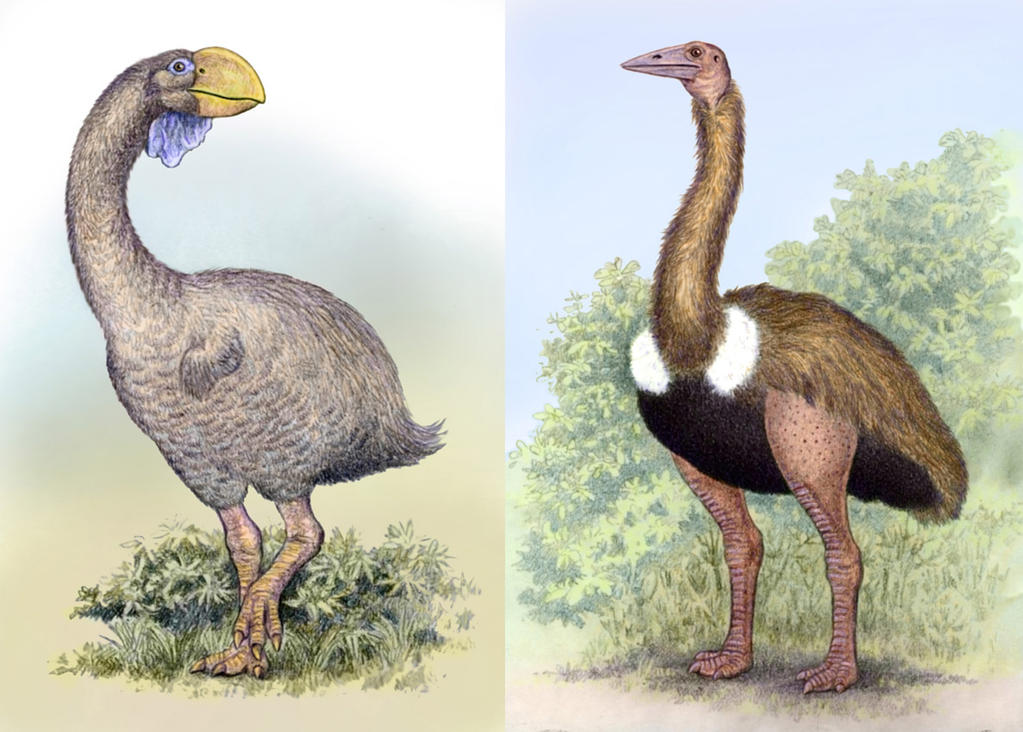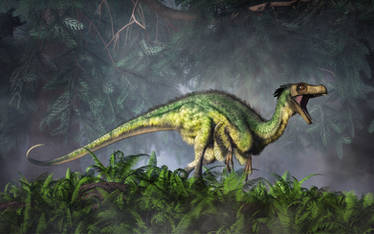ShopDreamUp AI ArtDreamUp
Deviation Actions
Description
More prehistoric bird illustrations for the talk I'm planning for the bird watcher's club! These are the two largest known prehistoric bird species: Dromornis stirtonii (left) and Aepyornis maximus (right). Both these species grew to about 3m/10' tall and 400-500 kg in weight. Dromornis lived in Australia, dying out in the Pliocene epoch; it was apparently a relative of ducks and geese, and it and its family are sometimes called the 'Demon Ducks of Doom'. It had a very heavy and powerful bill, and as with Diatryma, some people claim it was a herbivore while others believe it was a carnivore.
Aepyornis, the Elephant Bird, lived in Madagascar and may have survived until about a thousand years ago. It likely died out as a result of humans settling the island, either directly due to hunting or indirectly due to habitat destruction or perhaps due to diseases brought in along with human poultry. Of all living birds, the kiwi of New Zealand is apparently its closest relative! This means that the ancestors of the elephant birds probably reached Madagascar from Australasia, and must have been able to fly since at the stage they must have evolved these land masses were already separated by a vast stretch of ocean. Many elephant bird eggs have been found ... they're the largest known of any bird, equivalent to 160 chicken's eggs!
As with most extinct species, we don't know exactly what they looked like, and therefore there is much guesswork and imagination in these reconstructions. Pencil drawings, coloured in Photoshop.
Aepyornis, the Elephant Bird, lived in Madagascar and may have survived until about a thousand years ago. It likely died out as a result of humans settling the island, either directly due to hunting or indirectly due to habitat destruction or perhaps due to diseases brought in along with human poultry. Of all living birds, the kiwi of New Zealand is apparently its closest relative! This means that the ancestors of the elephant birds probably reached Madagascar from Australasia, and must have been able to fly since at the stage they must have evolved these land masses were already separated by a vast stretch of ocean. Many elephant bird eggs have been found ... they're the largest known of any bird, equivalent to 160 chicken's eggs!
As with most extinct species, we don't know exactly what they looked like, and therefore there is much guesswork and imagination in these reconstructions. Pencil drawings, coloured in Photoshop.
Image size
1187x849px 254.22 KB
© 2015 - 2024 WillemSvdMerwe
Comments28
Join the community to add your comment. Already a deviant? Log In
Even if Dromornis was a herbivore, I still don't think it was a bird to be messed with, any more than an ostrich or cassowary. I mean, look at that powerful beak!
I feel that way about Gastornis as well. I'm tired of articles describing it as a "gentle giant".
I feel that way about Gastornis as well. I'm tired of articles describing it as a "gentle giant".



































